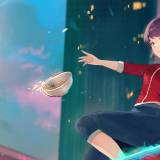Travis Touchdown – once-renowned assassin – is living the life of a comfortable hermit deep within a forest. Abandoning the society that formed him, his family, and potential enemies, he’s living in a trailer for a number of years. He peacefully resides here with his collection of video games and cat, until a particularly BAD man known as “Badman” confronts him. Out for revenge, Badman busts in with full intent to kill Travis. In the middle of their confrontation, the two get sucked into the mysterious “Death Drive Mk II” console and they put their differences aside in order to survive these virtual worlds full of parasitic beings. What Travis doesn’t realize is, this won’t just be a goofy trip through game worlds, as it quickly becomes a journey of absolute introspection, making him question what his life means to him as a man who was not only once obsessed with becoming a number 1 ranked killer, but someone that’s lived with video games as a main hobby for most of his life. A game developed under Grasshopper Manufacture (No More Heroes, Shadows of the Damned, Lollipop Chainsaw), this low budget, small crew indie-style game was lead by Suda51, who hasn’t directed a game in his own vision from beginning to end since the original No More Heroes back in 2007 until now. Travis is not striking back per se. In this game, Travis Strikes Again.

Originally released as a Nintendo Switch exclusive, Travis Strikes Again: No More Heroes has been officially ported to Playstation 4 and PC on October 17th, 2019 as the Complete Edition. Upon the original release, the game was met with a very mixed reception. Some folks were excited for a new chapter about everyone’s favorite otaku assassin, while others were displeased by the significant change in presentation, compared to the original titles on Wii. With these new ports hitting PlayStation 4 and Windows PC (via Steam) as well as a more legitimate sequel set to release next year, I wanted to take this opportunity to discuss my overall thoughts on the experience.

The core gameplay is fighting waves of enemy “bugs” that come in all different shapes and sizes. Whether they shield themselves from light attacks or overwhelm you with large swings of offense, these bugs can overwhelm you in an instant if you’re not careful. Besides the various moves you can perform with Travis’ beam katana (or Badman’s bat), there are various “chips” to collect that grant you special attacks that have a cooldown function when used. From telekinetically-tossing the enemies to blasting a heavy-hitting laser from the sky, these special attacks can be destructive against the bugs, but it’s best to use them sparingly so you’re never cornered without a means to fight back against the much stronger enemies. The opportunity of co-op means having another set of chips at your disposal and it also ramps up the chaotic nature of the gameplay as well.

Between fighting hordes of these digitized foes, there’s also the different gimmicks the game worlds provide, such as solving block-designed switch puzzles, and beating opponents in vector-styled drag races. Overall, the sharp turns that the gameplay takes when travelling across each world helps break the monotony up a bit, but the game still tends to feel tedious. In this essence, it’s almost exact to the original No More Heroes, where it suffered the same issue when it came to slashing through the main venues. However, another trend for Grasshopper games, the music goes a long way for enthralling these game worlds. Travis Strikes Again sports multiple tracks for every game world and every tune sounds extremely unique and perfectly fitting for the venues. The boss tracks are especially great.

As for experiencing the story, it’s mostly text-based, but it also allocates the different aspects of it to particular portions of the game. The personal tale about Travis and the emotions flooding into him as he’s experiencing these virtual worlds and learning more about Dr. Juvenile – the supposed antagonist – is what all the in-game dialogue is centered around when you’re dealing with the Death Drive Mk II’s game worlds. Meanwhile, the political aspect and background of said mysterious console is exclusively expressed through faxes you receive from someone involved in its development, who was also close to Juvenile. Lastly, the “Travis Strikes Back” scenarios is a series of minimalistic adventures that Travis goes through to find the “Death Ball” games for the console, presented in a way that leaves much of it to the imagination, all while having particular callbacks and cameos of characters from his previous games (that he happens to have the rights to).

While players that are unfamiliar with his early works, such as The Silver Case or Flower, Sun, and Rain, might feel alienated when playing the “Travis Strikes Back” chapters, thinking they should know who all these characters are beforehand, trust me when I say it barely helps you understand the full context. The whole thing feels much less grounded in reality and doesn’t provide a lot to the story, besides small instances. The faxes are a lot to take in, but provide heavy background to the Death Drive Mk II. Otherwise, these faxes don’t serve a significant purpose to the story that is Travis’ introspective journey, which is the absolute highlight of the game. When Travis Strikes Again first hit Nintendo Switch, many reviewers looked over the story entirely saying it lacked substance or made no sense. While the context is hard to notice at first, taking in everything, the main aspect of the game offers and Travis’ own thoughts, it’s clear that the story is about a man who’s dedicated a huge part of his life to video games and how he reflects on that. Down to how the death ball worlds are presented in the cutscenes that introduce each world to you.

Regarding the PlayStation 4 and PC ports of this game, they only saw improvements in regards to performance. Many of the in-game textures can be seen more clearly, down to the embroidery on Travis’ slick purple jacket. Loading times are also noticeably faster. There are also exclusive shirts for PS4 and PC that feature classic Namco titles, such as Mappy and Rolling Thunder. This port also contains all of the post-launch content from the Switch version, including many shirts for Travis and Badman to wear that were added through free updates, and the “Season Pass” DLC that has an entirely new game world, a 6-chapter story exploring Badman’s background, and two extra characters with their own unique move sets and special attack chips. Keep in mind, just about all of this content needs to be unlocked by completing the main campaign.

Overall, the gameplay experience does feel somewhat tedious at times, which is expected when talking about Suda51’s games. Still, the atmosphere and narrative are unlike anything I’ve ever experienced before. This and the main story of Travis travelling through these virtual worlds was an enthralling experience to decipher and understand. There’s a lot to take in when it comes to what this game represents, and why Suda51 wanted to make this in the first place. While it’s been stated that the game’s purpose was to rejuvenate interest in the “No More Heroes” series as well as convince particular rights-holders that a third entry is financially viable (parts of the story within this spinoff game set up future events for the upcoming sequel, after all), it’s clear that this was always meant to be a passion project and a way for Suda51 to let out so many raw emotions onto a game, as well as revel in the fact that he was able to direct a title completely in his vision once again. I recommend this game as a unique experience, and it is especially a trip that shouldn’t be missed by fans of Grasshopper’s library.
DISCLAIMER: Throughout playing both the Steam and PS4 version, we ran into a soft-locking bug that caused one of the last stages to be absolutely unbeatable. We have informed who we can in order to see if it can be mended with a pre-release patch of some sort before the game launches. We cannot confirm at this time if it fixed the issue, but will update this disclaimer as soon as we find out.

Reviewers Note:
If I have convinced you to give Travis Strikes Again a try, check out my video analysis on the game! I go into great detail on how much the story itself relates to Suda51 and his history with video games, and back many of my claims with heavy research and verbatim quotes from Suda himself I have found in interviews and biographies. Of course, I only recommend you do so after finishing the main story and post-game content.

















